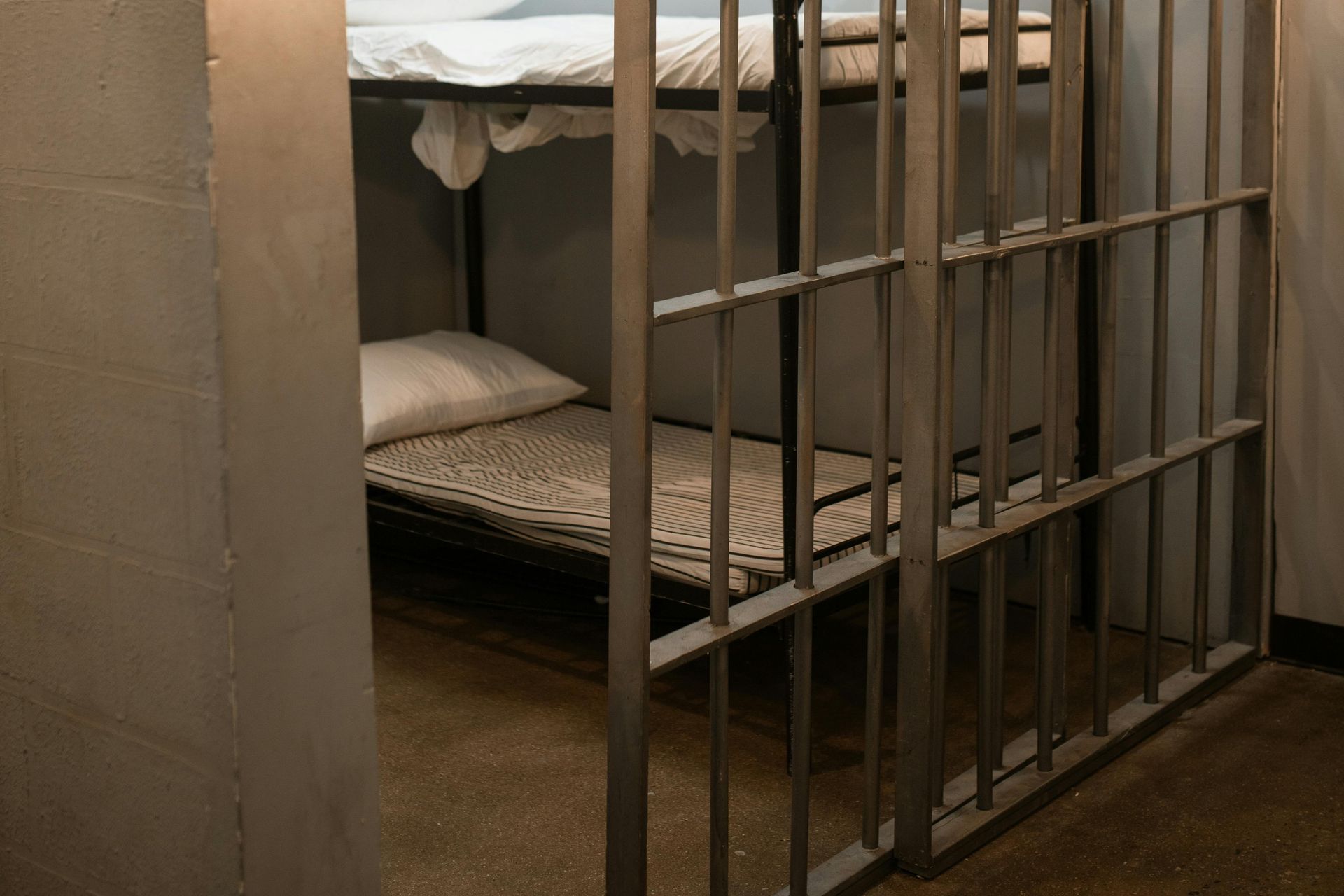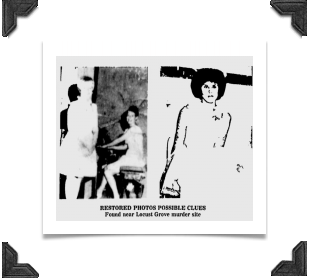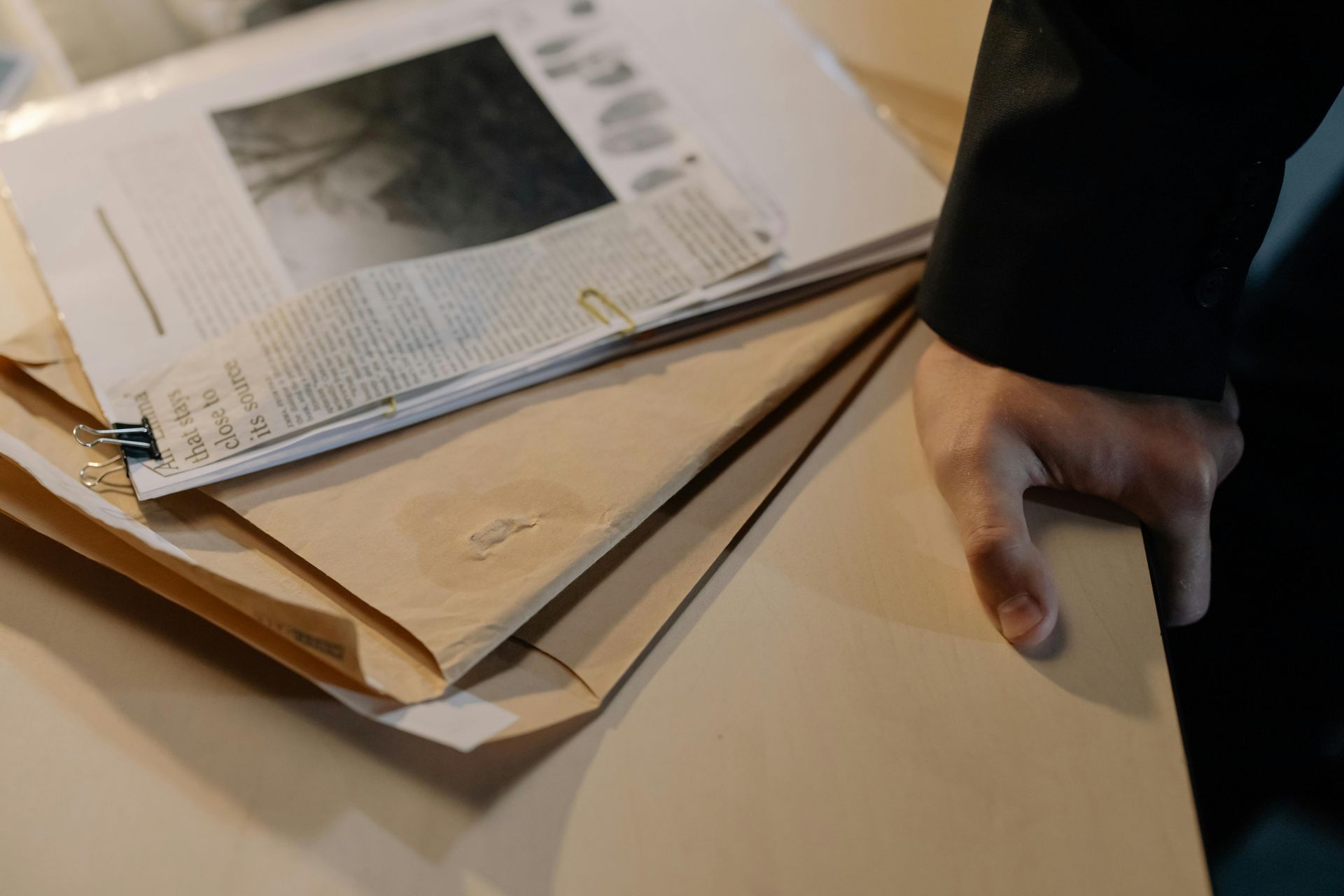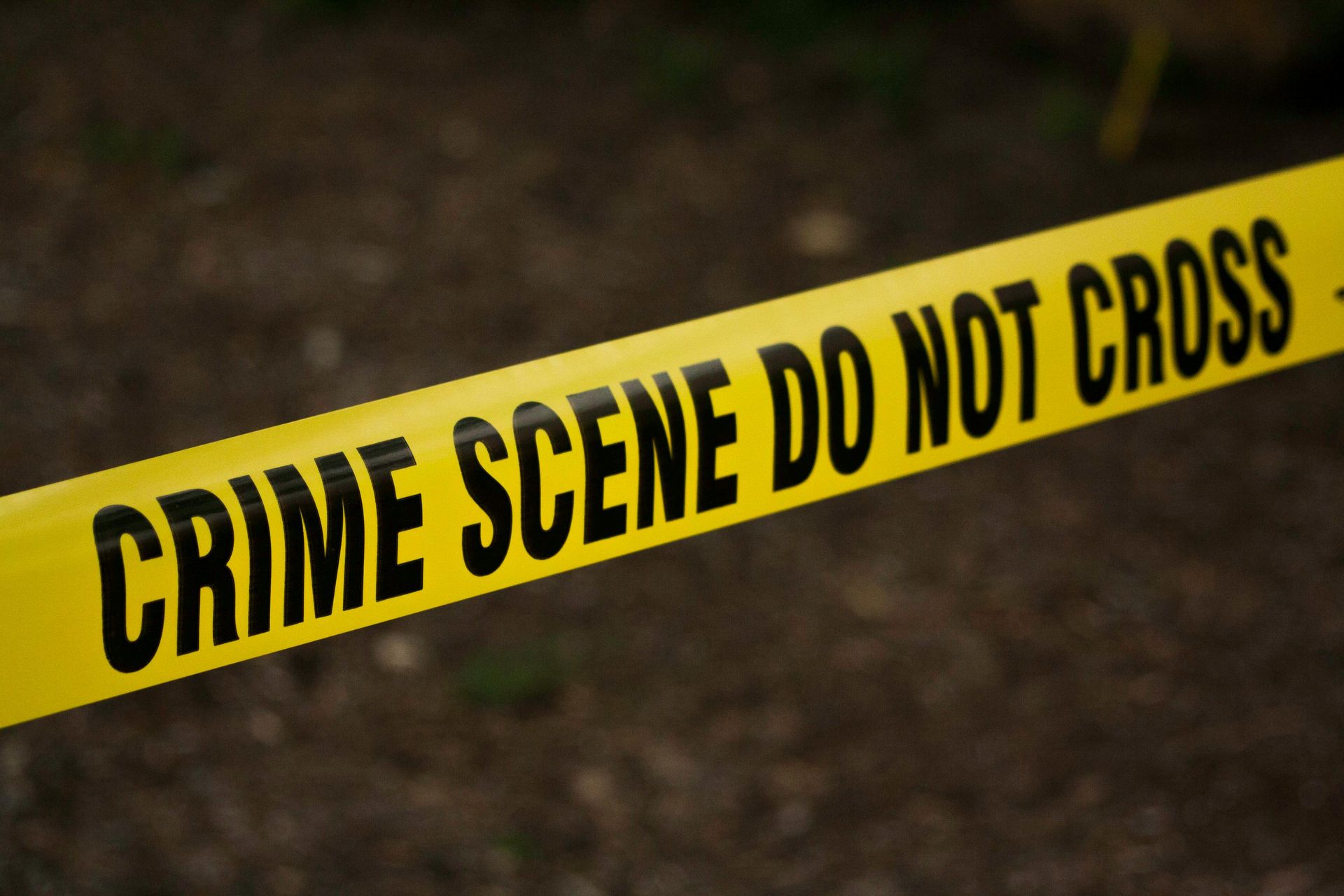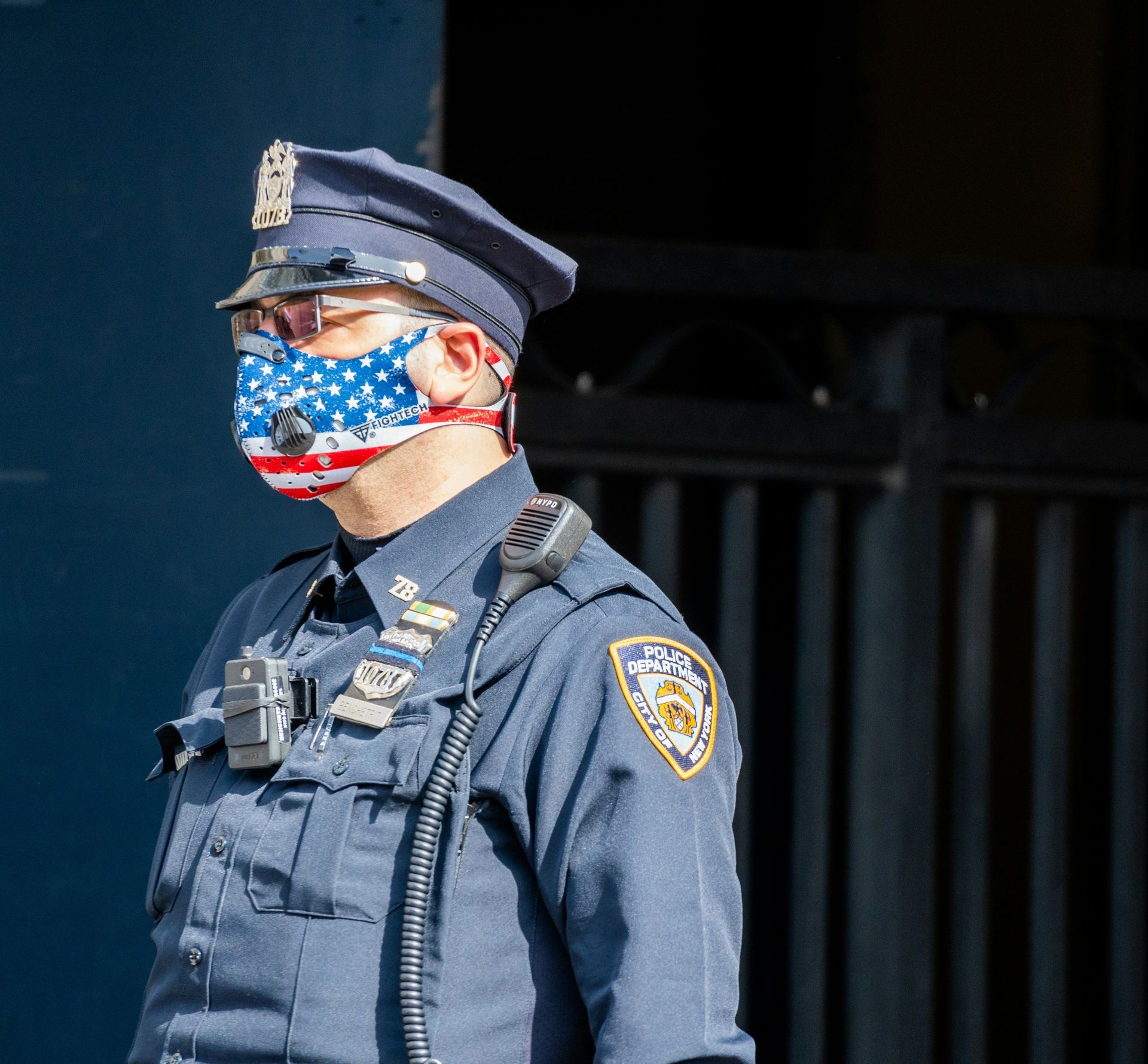Case: Oklahoma Girl Scout Murders
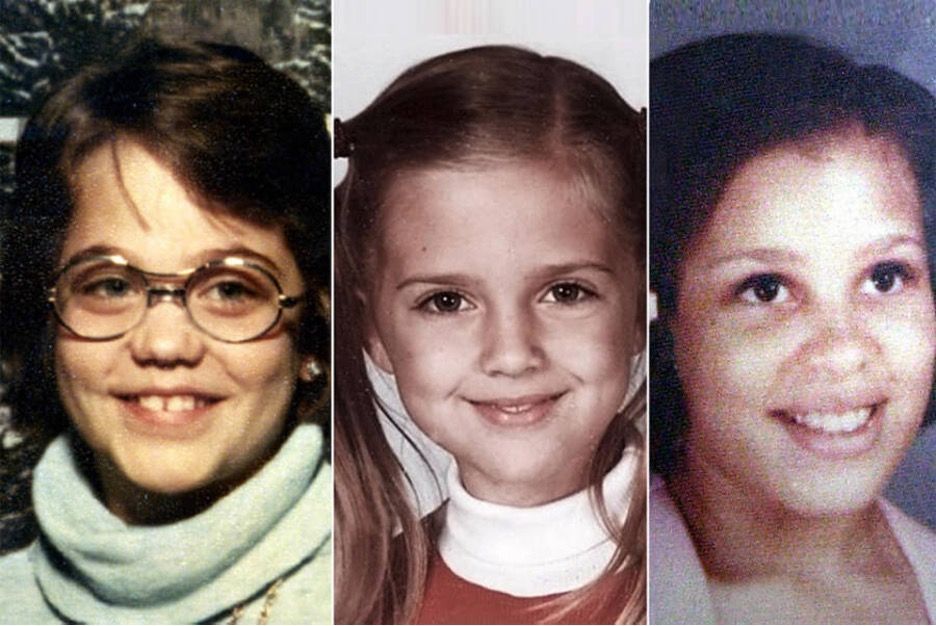
Within hours of arriving at a two-week Girl Scout camp outside Tulsa, Oklahoma, three young girls, Michelle Guse, 9, Lori Farmer, 8, and Doris “Denise” Milner, 10, were raped and murdered, their bodies found stuffed in sleeping bags on a trail more than 100 yards away from their tent in the early morning of June 13, 1977. “It was the bogeyman story,” said Andrea Fielding, the Director of Forensic Science Services at the Oklahoma State Bureau of Investigation. In the ensuing investigation, the police uncovered evidence in a nearby cave that linked to Gene Leroy Hart, a convicted kidnapper/rapist who’d escaped from a local prison in 1973 and been on the loose for the four years leading up to the murders. After a 10-month intensive manhunt, Hart was finally apprehended in the area and charged with three counts of first-degree murder. He was tried and ultimately acquitted of the triple homicide by a jury in March 1979. He died in prison two months later, where he was serving time for multiple prior burglaries. While not conclusive, recent DNA testing supports law enforcement’s theory that Hart was indeed the Oklahoma Girl Scout murderer.
The following is a timeline of the events that occurred.
Timeline
1967-1969
Doris “Denise” Milner
Denise Milner was born on February 5, 1967, in Mayes County, Oklahoma. Denise was known to be a friendly but not outgoing girl. Walter Milner, Denise’s father, was a member of the Tulsa Police Department. Denise was a straight-A student who had been admitted to a Tulsa school for exceptionally bright students. She had sold enough Girl Scout cookies to be able to attend the Girl Scout camp that summer with her friends. However, at the last minute, her friends backed out and Denise reluctantly set out for camp on her own. She didn’t want to say goodbye to her mom Bettye or her five-year-old sister and cried on the bus on the way to the camp. Denise was buried at Green Acres Memorial Gardens Sperry, in Tulsa, Oklahoma.
Michele Guse
Michele Guse was born on July 22, 1967, in Ottawa County, Oklahoma, the daughter of Georgeann and Richard Guse. She had a brother Michael. This was Michelle’s second time at Camp Scott, having attended the previous summer as well. She was known to be a shy, athletic girl who loved taking care of plants. She was buried in Fort Gibson National Cemetery in Fort Gibson, Oklahoma.
Lori Farmer
Lori Farmer was born on June 18, 1968, in Little Rock, Arkansas, to Sherri and Charles Farmer. Although Lori was the youngest Girl Scout at camp that session, she was known to be quite mature for her age. She was an avid reader, and had skipped straight to 3rd grade from 1st. She was the oldest of five children. Her father, Dr. Charles Farmer, had been the emergency room director at Tulsa’s St. John’s Medical Center. This was Lori’s first time away at camp. She was buried in Memorial Park Cemetery in Tulsa, Oklahoma.
Note: Angela Sweet was to share their tent that night
When ten-year-old Angela Sweet arrived at camp on June 12, 1977, the Camp Director informed her that she wouldn’t be able to sleep in the same tent as her own Girl Scout troop because there were too many girls for the tent. Only four girls were allowed in each tent. The director led her to the tent occupied by Guse, Farmer, and Milner. There was a spot in their tent since another girl either hadn’t been able to go on the trip due to illness or was showing up for the session late. Sweet moved her stuff into their tent and became excited as she started getting to know her three new friends. However, the Camp Director then told Sweet that her own troop would be able to squeeze her in after all, so Sweet switched tents and ended up not spending the night with Guse, Farmer, and Milner.
SUSPECT GENE LEROY HART’S HISTORY
1943
November 27, 1943
Gene Leroy Hart was born in Locust Grove, Oklahoma on November 27, 1943, making him 33 at the time of the murders. Hart was raised by his mother and reportedly did not have much of a relationship with his father. Hart had a sister, Tammy Foreman, who maintains her brother’s innocence in the murders.
Hart was known for his athletic abilities and had been a talented football player in high school.
According to girlscoutmurders.com, Hart grew up a mile away from the camp, was married shortly after graduating high school and had a son with his wife. They divorced a few years later.
As is the case with many violent criminals, there was an escalation in Hart’s criminal behavior.
1966
June 1966
Hart reportedly worked in Tulsa at Flint Steel. Instead of going to work, Hart kidnapped two pregnant women from a parking lot outside a Tulsa nightclub and drove them someplace remote in Mayes County. He brutally raped and sodomized the two women, both of whom survived their ordeal. Hart forced the women to ride in the trunk of his car and would take one or both of them out of the trunk to be with him inside the car. He tied them up, raped them repeatedly, covered them in brush, and left them for dead.
Note: Both women wore eyeglasses. Hart would try on their eyeglasses during the kidnapping to test out the prescription. He needed glasses himself. Eyeglasses would play a part in the Girl Scout murders as well. Note also that he took on more than one victim.
Hart was later caught for these vicious attacks and charged with rape and kidnapping. He confessed and was sentenced to three 10-year terms. However, these terms were served concurrently and as a result, Hart served only 28 months before being released on parole.
Hart then began committing home burglaries. Apparently, he committed four burglaries before this new crime spree was detected. The first three were not reported but the fourth burglary happened to be at the home of one of the only female Tulsa police officers on the force. Police arrived quickly and Hart was arrested. He was convicted of the four burglaries, and because he was on parole for rape and kidnapping at the time of his arrest, he was sentenced to four consecutive 90-year sentences.
1973
Early 1973: while serving time for the burglaries, Gene Leroy Hart escaped from Mayes County Jail but was quickly apprehended by police.
SEPTEMBER 1973
September 16, 1973: However, he escaped again and was still on the loose at the time of the murders in 1977, and in fact wasn’t apprehended until 1978.
THE SCENE OF THE CRIME: CAMP SCOTT
Located in dense woods about 50 miles outside of Tulsa in Mayes County, Oklahoma, Camp Scott first opened in 1928 under the name Camp Ma-Del-Co. A few years later, the name changed to Camp Scott, which would remain until the camp shuttered in 1977 as a result of the murders. The camp, which was owned by the Tulsa Scout Council and operated by the Girl Scouts, sat on 240 acres on the left bank of the Snake Creek and boasted twenty camp buildings and a pool. The small town of Locust Grove was two miles away.
Out there in the vast forestland, Camp Scott was pitch black at night.
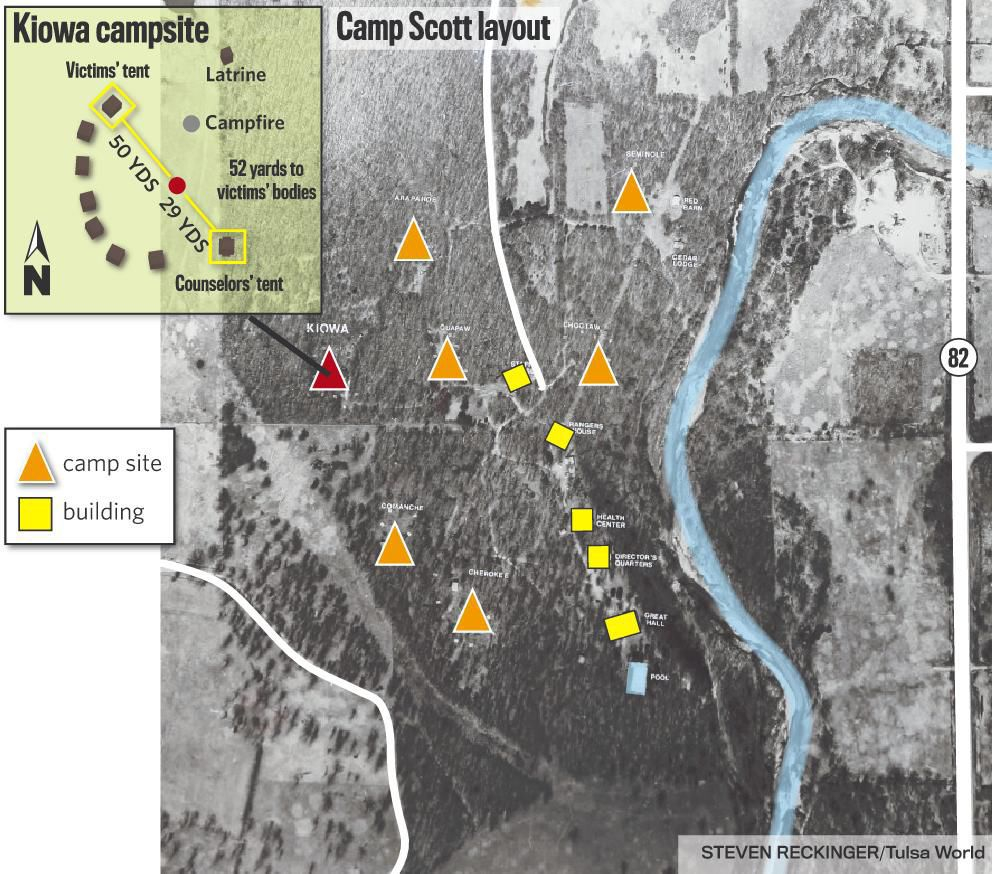
1977: THE CRIMES
APRIL 1977: AN OMINOUS THREAT
Prior to the summer camp season, some older Girl Scouts who are going to serve as camp counselors attend Camp Scott for a special training weekend. One of the girls, Michelle Hoffman, who had aged out of being a camper and was going to be an aide to the camp counselors that summer, returned to her tent to find that it had been ransacked. “Bags had been scattered all over the tent and some outside.”
A box of donuts that Hoffman had brought from home was now empty, the donuts stolen. Someone had left a threatening hand-written note inside the box, written on a small steno notepad.
According to more than one source, written over and over and over again on the first couple of pages of the notebook was the word, “Kill.”
Kill. Kill. Kill. Kill. Kill.
On another page of the notebook was a chilling message in all caps: “We’re on a mission to kill three girls.”
It was signed, “The Killer.”
Hoffman took the note straight to the Camp Director. Apparently, though, the note was treated as a prank and thrown out. Tragically, this threat was never taken seriously.
June 1977
June 12, 1977: First Day of Summer Girl Scout Camp at Camp Scott
June 12 -- the opening day of Camp Scott, and 140 Girl Scouts were to spend two weeks at the camp. The girls first arrived at the Girl Scout headquarters in Tulsa, Oklahoma, where they boarded buses to Camp Scott, which was owned and operated by the Girl Scouts.
Michelle Hoffman, the same girl who discovered the note in her donut box, also noticed Denise Milner, one of the only African-American girls attending the Girl Scout camp that summer, who looked nervous and upset as it was her first time going away to camp. Hoffman introduced herself to Milner’s mother and sat with Milner on the bus, telling her not to worry and reassuring her about how much fun she would have at camp. Once they arrived at the camp, Hoffman helped Milner with carrying her stuff in and finding her tent. Hoffman said that Milner’s tent was Hoffman’s “all-time favorite” because it was the one closest to the bathroom and kitchen.
The camp tents at Camp Scott appeared to look like cabins, but in actuality on the inside each consisted of only a wooden platform, furnished with four cots, no lights, and a large tentlike flap serving as the door. There was no barrier, and no type of lock, to keep anyone from gaining entry into the tents.
The three girls, Michelle, Lori and Denise, were assigned together to Tent #8 in the Kiowa Unit (sometimes referred to as Kiowa Camp or Kiowa sub-camp), an area inside Camp Scott. The girls didn’t know each other prior to arriving at camp that day.
The Kiowa Unit was one of the most remote areas of the entire Camp Scott property, and Tent #8 was the most remote tent as it sat on the edge of the semi-circle of eight tents at Kiowa. Not only was it the furthest from the counselor’s tent, Tent #1, at approximately 80 yards away, but it was also out of sight of the counselors as well, blocked by a camp shower building that sat directly in the line of sight between Tent #1 and Tent #8.
Three counselors were assigned to the Kiowa Unit, Carla Wilhite, 18, Susan Ewing, 18, and Dee Elder, 20. They were responsible for 27 campers in Kiowa.
At about 6pm that night, a thunderstorm hit the area, sending all the campers scrambling into their tents for the night. The three girls were going to write letters and play cards before bedtime.
Camp counselor Carla Wilhite noted that the three girls were “three of the quietest kids” individually, but that their tent was “just as loud and lively” as the other tents before night came.
At 7:45pm, Lori Farmer wrote her family a letter that evening, the final letter of her life:
“Dear Mom and Dad and Misti and Jo and Chad and Kathy. We’re just getting ready to go to bed. It’s 7:45. We’re at the beginning of the storm and having a lot of fun. I’ve met two new friends, Michele Guse and Denise Milner. I’m sharing a tent with them. It’s started raining on the way back from dinner. We’re sleeping on cots. I couldn’t wait to write. We’re all writing letters now ‘cause there’s hardly anything else to do. With love, Lori”
After writing letters, the girls played cards and had story time before bed. Denise was homesick and upset and asked to call her mom. Dee Elder comforted Denise and convinced her to wait until the following day to call her mom.
Wee hours, June 12 - June 13, 1977: strange sightings and creepy noises
At some point that night, reportedly at about 10pm, a counselor from the Comanche Unit, near the Kiowa Unit, noticed a faint light coming from the woods. She got up to investigate and saw that it was moving toward Kiowa. The counselor assumed that it was another counselor out there using a flashlight, thought that everything was okay, and went back to bed.
Dee Elder made a tent check of Kiowa at about 10pm and found everything to be okay. At around midnight, Carla Wilhite heard girls giggling and escorted them from the toilets back to their tents.
At around 1:30am, Wilhite went out and told the girls in Tent #6 to stop making noise. At that time, she heard a strange low guttural noise behind the tents. She tried shining her light out in the woods but couldn’t find the source of the noise, which she continued to hear intermittently throughout the night.
One of the Kiowa counselors in Tent #1 heard strange noises in the middle of the night, saying, “It didn’t sound human. It didn’t sound animal.” She got up to investigate but the noises stopped suddenly so she also went back to bed.
Multiple people reported hearing moaning sounds at 1:30 am from the area of Tent #8. There were also reports of guttural noises from the woods behind Tents #1 and #2.
A camper in Tent #7 said that she woke up when someone with a flashlight suddenly opened the flaps to her tent at 2am, and then just as quickly disappeared.
Another camper reported hearing a scream at 3am from the general vicinity of Tent #8.
Someone else reported hearing someone crying, “Momma, Momma” in the night.
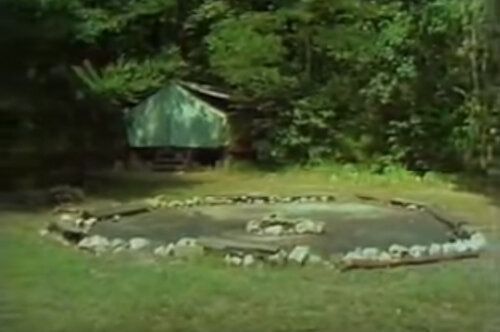
June 13, 1977: Discovery of the Triple Murder
At approximately 6am, Carla Wilhite, a counselor in the Kiowa, got up early to take a shower before the campers got up. Something caught her eye under a tree on the trail to the showers, something that shouldn’t be there. Wilhite discovered that it was sleeping bags. Exposed within the sleeping bag, she found Denise’s dead body, face up and naked from the waist down.
Two other sleeping bags were close by, one with Lori’s body and one with Michelle’s body. Two of the sleeping bags were zipped closed but Denise’s was the one that was open.
The horrible truth was that all three of the girls occupying Tent #8 had been sexually assaulted and murdered sometime during the night of June 12 - June 13.
Wilhite woke up her fellow counselors Ewing and Elder to help her check on the children in Kiowa. They found that all the girls from Tent #8 were missing. Wilhite rushed to the nurse’s station, and as the nurse went to check for signs of life, Carla went to inform Camp Director Barbara Day of her discovery.
Richard Day, Barbara’s husband, arrived on the scene and discovered the other two girls’ bodies in their respective sleeping bags, Lori Farmer’s and Michelle Guse’s. He covered the naked lower half of Denise with another sleeping bag.
Barbara Day called Highway Patrol officer Harold Berry.
Law enforcement arrived on the scene by 7:30am.
By 8am, Sheriff Glen “Pete” Weaver had requested help from the Oklahoma State Bureau of Investigation (OSBI), given the magnitude of the crimes.
It was clear to the police right away that at least one of the girls had been attacked inside the tent. Blood was found pooled and splattered inside the tent, including on the wooden floor, and on the mattresses, pillows and cots. It appeared that someone had tried to wipe up some of the blood using mattress covers and towels.
It was reported that Michelle and Denise had been tied up. They were found with cords around their bodies and tied to their wrists. Denise had a rope and a towel knotted around her throat. Lori and Michelle’s mouths had been sealed with black electrical tape.
A red flashlight was found on top of one of the girl’s bodies.
In addition to the red flashlight, which had a partial fingerprint, police found nylon rope, duct tape, and a crowbar. The flashlight had been altered in a couple of ways. Tape had been placed over the light portion of the flashlight with a small pinhole in the plastic, which significantly dimmed the light. Also, a newspaper was found jammed inside, apparently to keep the batteries from making any rattling noises. The paper was from the April 17, 1977 edition of the Tulsa World newspaper, pages 5-12.
The New York Times reported that the police were not releasing details about their investigation, but also noted that it was widely reported that a large bloody footprint had been discovered on the floor of the tent.
The Times further reported that the police had found evidence that, either before or after the murders, the killer had stayed in a deserted house located on a 110-acre ranch property that adjoined the Camp Scott property. The Shroff Ranch, owned by Jack Shroff, was within a mile of the camp. According to Shroff, various items had been stolen from his home, including food, tape, beer, and rope. The rope missing from his home was similar to the rope found near the bodies.
Police also discovered that someone had entered multiple tents at the camp that night. Eerily, someone had stolen eyeglasses from various of the girls’ tents and placed them throughout the camp.
At about 10am, Camp Scott was evacuated. With no explanation to the campers, chartered buses hurriedly returned the group of surviving campers to Tulsa to be reunited with their families.
The camp was shuttered, forever, and remains closed to this day.
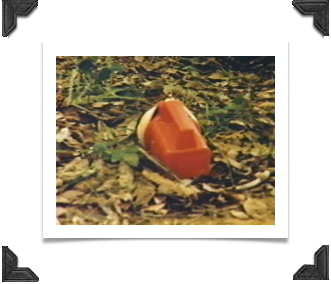
Still June 13, 1977: The Investigation Begins
The Mayes County Sheriff Glen “Pete” Weaver was assigned to investigate the case. He had served as Sheriff from 1961-1971, and then again from 1973 (until 1981). District Attorney Sid Wise was also heavily involved right from the beginning in the triple homicide investigation.
The bodies of the girls were located about 150 yards away from their tent on the side of a trail. This trail went alongside the Kiowa Unit and also led to the camp’s back gate. Although the front and back gate of the camp were locked, they were unguarded at night. In addition, there was no fence around the perimeter of Camp Scott.
The murder scene was horrific. Inside the tent, police found parts of the tent broken, playing cards scattered, and blood all over. One of the few places where no blood was found was on a cot near the right side of the tent, apparently where Denise was sleeping. Police surmised that Lori and Michelle were likely killed in the tent, but that Denise was either carried or forced to walk to the location where the three bodies were found. There was blood on the mattresses of the first two cots (presumably Lori and Michelle’s), and there was blood on the floor of the tent beside each one of those beds.
Initially there was speculation that perhaps a woman had committed the horrific crimes, based on an initial statement the DA made that the girls had been sexually abused but not raped before they were murdered.
Autopsies were performed on the three girls’ bodies. Michelle and Lori were determined to have died from blunt force head trauma. Was the crowbar the murder weapon? Denise had also suffered a massive blow to the head, but her cause of death was from strangulation. Two of the girls had indeed been raped, and one had been sodomized. Details as to which girl was sexually assaulted in which way has not been released.
Note: Although it is consistently and nearly universally reported that two of the girls were raped and one was sodomized, I’ve also seen a report that says that the coroner said that the girls were sexually assaulted but not raped. This inconsistency is out there and is confusing.
It was reported that hair and semen were found on the bodies and/or in the tent.
June 16, 1977
Sheriff Glen Weaver claimed to have found the murder weapon. District Attorney Sid Wise almost immediately denied this. I believe this is referring to the crowbar.
According to at least one source, by this date law enforcement had searched a nearby cave. More details below.
June 17, 1977
Funeral services were held for Michele Guse at 10am.
According to a New York Times article by John M. Crewdson published on this date, law enforcement, including officers from the Oklahoma State Bureau of Investigations, were busy conducting an intense manhunt. They brought German shepherds in from Pennsylvania to track down the killer. Police described the killer as surely a “physically agile” man, who’d been able to strangle Denise, kill the other girls with blows to the heads, and then carry the bodies more than 100 yards away from their tent to where they were discovered.
The police searched three caves that are pretty well hidden from sight but are known to be n the area near Camp Scott. Police dogs located one of the caves, two miles from camp, where police found evidence linked to the murders: a flashlight battery, newspapers from the same edition of the Tulsa World, eyeglasses that were apparently stolen from the camp, duct tape that matched the kind found on the girls’ bodies, and two photos of women. Additionally, on the wall of a nearby cave was written: “The killer was here. Bye bye fools. 77-6-17.”
According to koco.com, the two photos of the women gave law enforcement a lead. Sheriff Weaver told the media that he believed one person, a man, was the killer. He believed that the photos found in the cave may have been developed by a man while he served time in Granite Reformatory. Based on these photos, Gene Leroy Hart became the leading suspect.
Note: I haven’t been able to find out why these photos convinced Sheriff Weaver that Hart was involved or why he was sure that Hart was the one who had developed these photos while in prison.
1978
April 6, 1978
After a 10-month search, the largest and longest manhunt in Oklahoma history up to that date, police find and apprehend Gene Leroy Hart at a cabin about 45 miles from Camp Scott. Police had the assistance of 40 FBI agents and spent over $1mm on the manhunt. They may also have received a tip from an informant as to Hart’s whereabouts.
Hart was taken to Oklahoma State Penitentiary and charged with three counts of first-degree murder.
Hart had grown up in the area and had a group of staunch supporters. Although many criminal defendants seek a change of venue out of fear that the potential jury pool will be tainted by the shocking nature of their crimes, it was in Hart’s best interests not to have a trial in a different venue. He did not seek a change in venue.
1979
March 1979
March 19 – March 30, 1979: The Trial
The courtroom was packed for the trial of State of Oklahoma v. Gene Leroy Hart, which took place in the Mayes County Courthouse, Locust Grove, Oklahoma before Judge William Whistler. The initial prosecutor was Sid Wise (before he resigned) and the defense attorneys were Garvin Isaacs and Gary Pitchlynn.
The prosecution’s arguments/evidence:
P argued that Hart’s glasses had been stolen from the Girl Scout camp
P argued that Hart’s hair resembled hair found on the duct tape
The prosecution’s first two witnesses were camp counselors who described the events. The main challenge for the prosecution, in pre-DNA testing, was in establishing a solid connection, beyond a reasonable doubt, between Hart and the physical evidence found in the case.
Dr. John MacLeod from Cornell University Medical Center testified for the prosecution that sperm found at the death scene linked to Hart. According to an article in Oxygen.com, physical evidence was used against Hart in the murder trial, “including sperm that showed ‘only .0020% of the population met the unique characteristics contained in that evidence, including Hart,’ according to the OSBI.”
Isaacs and Pitchman argued that evidence was planted against their client and pointed the finger at William A. “Bill” Stevens, an individual who was serving time for rape and kidnapping.
Notably, the defense called to the stand a waitress named Dean Boyd, who testified that she’d seen a nervous man at the diner she worked at (the Midway Café in Chotcaau, OK), 12 miles from Camp Scott, the morning of the murders. She identified the man as Stevens, whose photo Boyd later saw on TV news, and contacted the defense attorneys. She remembered based on the televised photo that he had been to the diner the morning the girls were killed.
According to the New York Times, Boyd testified that, “Mr. Stevens drove up to the Café between 5 and 6 A.M., took off his shirt outside and put another one on. ‘He was awful nervous.’” She became suspicious of him and how he kept looking at his hands and putting them in his pockets, so she called the police. However, Stevens left the diner before police arrived.
Stevens’ photo had appeared on the news because another witness, Joyce Payne, testified during the trial that she had given the flashlight found near one of the bodies to Stevens in 1977. She recognized it by the scratches and tape on it. Payne testified that “he visited her home in Okmulgee the morning the bodies were discovered and had claw marks on his arms and reddish brown stains on his boots.”
(According to another source, a camper had even seen Stevens on the camp’s grounds sometime before the murders. I haven’t been able to verify that with any other sources.)
In its rebuttal case, the prosecution called several witnesses to try to discredit the notion that Stevens was the Girl Scout murderer. According to the New York Times, the strongest rebuttal witness was a chemist with the Oklahoma State Bureau of Investigation who testified that hair found at the crime scene in Tent #8 and on the duct tape used in the murders didn’t match hair samples taken from Stevens. The prosecution put on other witnesses who testified that the hair could’ve come from Hart.
According to the NYT, the prosecution put on another expert who testified that sperms samples taken from Stevens weren’t similar with “the patterns of sperm structure” found inside the bodies of the girls, whereas MacLeod had testified early in the trial (during the prosecution’s case-in-chief) that his test had shown “it would not be unreasonable” to infer that the sperm in the victims had come from Hart.
The NYTimes article, dated March 31, 1979, ends with this statement that I don’t fully understand: “However, all of the expert witnesses said that hair and sperm comparisons could not be used as positive identification of an individual.”
Note: I’m not sure if this statement is because there wasn’t a high enough degree of confidence in the matches to Hart, or because back in the 1970s this type of evidence wasn’t yet deemed reliable enough to constitute a positive identification. By the 1990s, I personally called an FBI hair expert in a takeover bank robbery trial who testified that hair samples found in a ski cap matched hair samples taken from the defendant’s head.
Digression/more information on William A. Stevens:
Witnesses Joyce Payne (Paine?) and her son Larry Short testified as mentioned above, regarding the flashlight, scratches on Stevens’ arms, and red stains on Stevens’ shoes. Stevens always maintained that he was working in Seminole when the girls were murdered, which his employer and a timecard confirmed.
There’s a whole convoluted story involving Payne’s boyfriend DeWayne Peters who claimed that Stevens had confessed to the Girl Scout murders. He later recanted and blamed Payne for feeding him false information to make the phony confession story seem believable. The upshot was that Payne and Short were charged with perjury relating to their testimony at Hart’s trial. After a jury trial on the perjury case, the jury deadlocked, and Payne ended up pleading no contest (similar to a guilty plea without actually saying “guilty”) to a reduced misdemeanor charge of compounding a felony. The charges against her son were dropped.
Stevens and Peters were sentenced to prison for the kidnapping and robbery of a woman from Kansas in November 1977. Stevens also pleaded guilty to raping the woman and leaving her to die in the trunk of her car. Stevens was stabbed to death in his prison cell in July 1984. He was 27 when he died.
March 30, 1979: The Verdict
According to the New York Times, the jury deliberated for seven hours before returning a unanimous not guilty verdicts on all counts, “to thunderous applause.”
The jury was reportedly made up of six men and six women.
Hart had a large following in the community, many who couldn’t believe their hometown football star could be guilty of murdering children.
Note: According to morelaw.com, Judge Whistler said that the Hart trial was the most stressful case he ever presided over and that he went to Europe afterward to rest and recover from the case.
After his acquittal, Hart remained in prison serving time on his four previous burglaries.
According to girlscoutmurders.com, Sherri Farmer, Lori’s mother, reported that Judge Whistler told the families of the victims that “sometimes in our system of justice, even the guilty are permitted to go free.”
Note: The D.A. Sid Wise made a book deal with a reporter, Ron “RL” Grimsley, whereby Wise would give Grimsley access to confidential information related to the case so that Grimsley could write a book about the murders. Grimsley was named campaign manager for Wise, who was planning to run for Oklahoma’s Attorney General. According to girlscoutmurders.com, “This arrangement, when brought to light, delayed the trial several months because Wise was forced to resign as D.A. due to his actions involving Grimsley.” “Buddy” Fallis, the DA in Tulsa at the time of the murders, was brought in to prosecute the Girl Scout murder case after Sid Wise’s resignation.
Note: A fact worth noting, given that it was mentioned in numerous articles and seemingly affected many aspects of the case, from the police investigation to the arrest and jury trial, is that Gene Leroy Hart was a Cherokee Native American. There was a degree of mutual distrust between law enforcement and Cherokee Medicine Men, with accusations of police planting evidence and stories about Medicine Men assisting Hart while he was a fugitive, putting curses on the police search dogs (apparently one or two of the dogs suffered untimely deaths), serving as informants, and the like. The case had racial overtones. Some of the participants in the case noticed what they perceived as similarities between the Gene Leroy Hart murder trial and the later murder trial of O.J. Simpson.
JUNE 1979
June 4, 1979
Only two months after being found Not Guilty, Hart died in prison of a heart attack. According to the Oklahoman, in an article by Charles T. Jones dated June 9, 1997, Hart had a family history of heart disease and was determined to have died of a heart attack brought on by severe blockage of his coronary arteries.
THE AFTERMATH
1985
According to an article by Griff Palmer in The Oklahoman, dated March 23, 1985, the Farmer and Milner families sued the Magic Empire (Girl Scout) Council and the Hartford Insurance Company, seeking combined damages of $5 million, alleging that the defendants’ negligent operation of the camp created an environment that allowed the murders to occur. Hartford Insurance had carried an umbrella liability policy on Camp Scott. As part of their case, the plaintiffs/victims’ families introduced documents which showed that a Hartford “loss control consultant” had toured Camp Scott and deemed safety conditions to be acceptable.
The case went to trial in 1985. A jury found for the defendants and determined no liability.
The Farmer family opened a Parents of Murdered Children chapter in Oklahoma. The Girl Scout Murders sparked the victims’ rights movement in Oklahoma, largely the work of the parents of the murdered girls.
Richard Guse, father of Michele Guse, helped found and was the first Chairman of the Oklahoma Victims Compensation Board.
1989
DNA testing/results
According to an article on Oxygen.com, “in 1989, the state tested DNA from a semen stain found on a pillowcase in Michelle Guse’s sleeping bag, according to KOCO, but they were unable at that point to get more than a partial match. It did not exclude Hart as the contributor. It’s unclear if a fuller DNA profile was developed from that or another sample more recently. Oxygen.com reached out to Sheriff Reed and the OSBI for clarification about the DNA testing in the case but did not receive an immediate response.”
According to an article in The Oklahoman dated October 25, 1989, “Genetic testing conducted by the FBI in 1989 linked Hart to the slayings but could not determine conclusively whether he was the killer. The confidential tests matched Hart’s body fluids with three probes of DNA evidence obtained at the crime scene.”
The Oklahoman further wrote: “One person in 7,700 American Indians would match the crime scene sample as Hart did, The Oklahoman was told. Hart was a Cherokee Indian. ‘If all five probes had matched, it would have been one in 3 billion,’ one source said. ‘With three of five matching it is one in 7,700. That means if you got tests from 7,700 American Indians one of them should match, which is the reason why the test is not conclusive.’”
1996
According to an article in the Oklahoman, a private investigator named Ted LaTurner looked into the case and got a petition approved to have the Mayes County grand jury look at some leads that he found. LaTurner also said he had a witness who named three suspects, none of whom were Hart. The three suspects named were Sonny James, Frank Justice, and Bill Stevens.
Mayes County Sheriff Harold Berry later called LaTurner a “hack investigator seeking the grand jury for notoriety and gain.” He said that “Gene Hart is dead, and all the physical evidence pointed to him.”
2010?
Note: The TV news story I watched, that contains the interview of Andrea Fielding referenced below, from koco states that Fielding decided to retest the DNA in 2010. This reporting is confusing because all other sources discuss DNA testing performed only in 1989 and 2019, with the most recent 2019 results being released just this month in May 2022. I can’t find any other reference to DNA testing in 2010 Fielding’s interview doesn’t mention the year.
I watched the interview with Andrea Fielding, Director of Forensic Science Services for OSBI, who said she picked up the case so that evidence from the scene could be retested using more modern techniques. OSBI looked at all the autopsy samples that were submitted from the three victims, the clothing items, and sleeping bags. In a TV interview on koco Channel 5 abc, Fielding stated that unfortunately, because the samples had been collected in 1977 and preservation, collection and testing techniques had changed since then, some of the items had not been preserved the way they should’ve been. A lot of the items were too degraded to get any DNA results.
However, they were able to get partial DNA profiles from fingerprints on the flashlight and semen on a pillow. Fielding said: “They were not able to exclude Gene Leroy Hart as being a contributor to that DNA profile.”
The other partials connected to the victims.
Fielding: “There were none that were not linked to somebody known in this case.” “As far as the OSBI goes, and the evidence that we have, our belief is that Gene Leroy Hart committed the murders. And the evidence that we have doesn’t exclude him; it doesn’t point to anyone else, and so we will close the case that way.”
2022
MAY 2022
DNA Testing Results Announced
The latest DNA testing was done in 2019, with investigators utilizing new DNA testing that wasn’t available at the time of Hart’s trial in 1979. According to newson6.com, the testing cost $30,000, money the sheriff’s office didn’t have, but the citizens of Mayes County raised all the money for it.
The results of these tests were just reported this past week in May 2022. While officially inconclusive, the DNA results eliminate several other potential suspects but do not exclude Hart.
Mayes County Sheriff Mike Reed is quoted as saying, “Unless something new comes up, something brought to light we are not aware of, I am convinced where I’m sitting of Hart’s guilt and involvement in this case.”
According to Oxygen.com, in an article by Jax Miller dated May 5, 2022, “Mayes County Sheriff Reed said that new DNA evidence developed would have convicted Gene Leroy Hart of the murders.”
Sheriff Reed points out that OSBI interviewed 139 people as possible suspects during the investigation. He remains convinced that Gene Hart was the killer.
SOURCES:
The New York Times, “Tulsa Mourns 3 Girl Scouts Murder in Camp,” by John M. Crewdson, June 17, 1977
The New York Times, “Convict Acquitted in Death of 3 Girl Scouts,” March 31, 1979 (author not provided on my digital version).
koamnewsnow.com, “DNA points to longtime primary suspect in 1977 Oklahoma Girl Scout slayings, sheriff says,” by Time Stanley, Tulsa World, May 6, 2022
The Oklahoman, “Answers to Scout Murders Case Gone With Slain Former Suspect,” by Judy Fossett, July 16, 1984
The Oklahoman, “Slain Scout’s Dad Testifies at Suit Trial, Recalls Girl’s Exceptional Memory,” by Griff Palmer, March 23, 1985
The Oklahoman, “New Trial Plea Rejected in Lawsuit Against Girl Scout Council,” May 7, 1985 (no author provided)
The Oklahoman, “DNA Tests Link Gene Leroy Hart to Girl Scout Deaths,” by Robby Trammell, October 25, 1989
The Oklahoman, “19 Years After Scout Deaths, Investigator Seeks Answers,” by Mark A. Hutchinson, June 16, 1996
The Oklahoman, “Still No Justice After 20 Years Slain Girl Scouts’ Parents Haunted by Murders,” by Charles T. Jones, June 9, 1997
Tahlequahdailypress.com/news, “Crime Rewind: Officials say Girl Scout murder case unsolved” by Keri Thornton, November 11, 2021
koco.com, “Oklahoma Girl Scout Murders: The criminal history of prime suspect,” by Brooke Withrow, updated May 3, 2022
koco.com, “Oklahoma Girl Scout Murders: A look into one of Oklahoma’s most notorious cold cases,” by Brooke Withrow, updated May 4, 2022
newson6.com, “Newly-Released Evidence Points to One Killer in Girl Scout Murders,” by Reagan Ledbetter, May 9, 2022
claremoreprogress.com/news, “Catoosa resident shared tent with Girl Scouts murdered 40 years ago,” by Diane Dickinson, June 13, 2017
allthatsinteresting.com, “Inside the Horrific Oklahoma Girl Scout Murders that Remain Unsolved to This Day,” by Marco Margaritoff, checked by Erik Hawkins, September 26, 2021
abandonedok.com/camp-scott/, article by AOK Photojournalist Emily Cowan
strangeoutdoors.com, “The Oklahoma Girl Scout Camping Murders,” February 10, 2021 (updated May 2022, no author provided)
Oxygen.com, “Sheriff Says DNA Links Longtime Suspect to 1977 Girl Scout Murders,” by Jax Miller, May 5, 2022
morelaw.com, “State of Oklahoma v. Gene Leroy Hart,” March 31, 1978
girlscoutmurders.com – maps, diagrams, people involved, timeline, etc.

